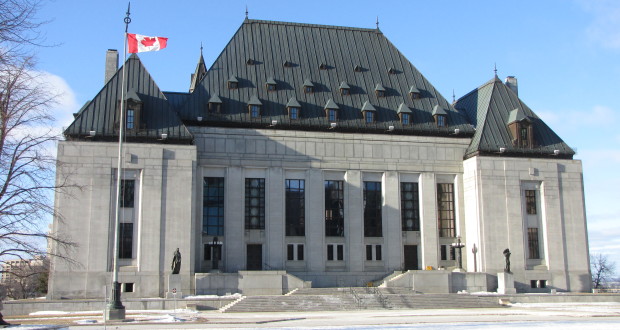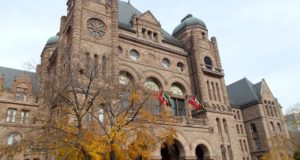The Supreme Court delivered a bizarre decision last week in R.v. Comeau. By way of background, Comeau concerned the interpretation of s.121 of the Constitution Act, 1867, which states: “All Articles of the Growth, Produce, or Manufacture of any one of the Provinces shall, from and after the Union, be admitted free into each of the other Provinces.” The issue for the Court was whether s.134(b) of New Brunswick’s Liquor Control Act, which, inter alia, prohibits the importation of out-of-province alcohol beyond a certain threshold, was unconstitutional on the basis that it offended s.121. The trial judge said that it was, but the Supreme Court overturned this decision and upheld the constitutionality of s.134(b).
The Court’s decision has already faced a good deal of criticism, much of it justified in my opinion. Comeau casts itself in the language of settled doctrine, but, for the most part, it offers anything but. The Court’s interpretation of s.121 is novel and its reasoning is confusing and, at times, contradictory. In the following article, I will discuss the doctrinal points that, in my opinion, the Court did not apply correctly. These include 1) stare decisis, 2) the principles of statutory interpretation and 3) the exhaustiveness doctrine.
1) Stare Decisis for Thee but not for Me
The Comeau decision includes some important language on stare decisis, which the Court described as “fundamental for guaranteeing certainty in the law” (para. 26). Only in “extraordinary exceptions” can a lower court deviate from the decision of a higher court. This makes eminent sense, but it also seems to be at odds with the rule established in Canada v. Bedford. In Bedford, the Supreme Court held that the binding precedent of a higher court “may be revisited if new legal issues are raised as a consequence of significant developments in the law, or if there is a change in the circumstances or evidence that fundamentally shifts the parameters of the debate” (see para. 42). These exceptions are certainly not boundless, but nor can they plausibly be characterized as “extraordinary.” As Bedford and Carter demonstrate, the threshold of what constitutes “new evidence” to justify overruling past precedent is not exceptionally high.
The Court distinguished Comeau and Bedford on the basis that Bedford involved new legislative and social facts – “facts about society at large” – whereas Comeau involved “simply a description of historical information and one expert’s assessment of that information.” This strikes me as an arbitrary distinction. The principal purpose for undertaking a historical analysis is to determine whether the initial decision was correct. Correctness remains one of the central factors a court will consider in determining whether to overrule one of its own precedents (“horizontal” stare decisis), and in determining correctness, courts will regularly look to the original meaning and purpose of a provision (See Leonid Sirota & Benjamin Oliphant, “Originalist Reasoning in Constitutional Jurisprudence” (2017) 50 UBC L Rev 505 – 574, at 515-516), and thus to historical evidence. Indeed, the Court in Comeau acknowledged that “[h]istorical evidence can be helpful for interpreting constitutional texts,” and went on to consider the legislative intent behind s.121. I appreciate that the Court may have been attempting to put the Bedford genie back in the bottle, as it were, but there is no principled basis to allow lower courts to overturn the decisions of higher courts where the trier of fact determines that the “social and factual landscape” has changed, but not where the impugned decision is demonstrated to be incorrect.
I do not want to be mistaken as arguing that the Court in Comeau was bound to accept the historical evidence led at trial. In my view, the Court was correct in noting that some of the historian’s evidence went directly to the ultimate issue – the correct interpretation of s.121 – and was thus inadmissible under R. v. Mohan. And of the evidence that was admissible, the trial judge’s findings of fact should not have been subject to the onerous palpable and overriding error standard that applies to adjudicative facts. But here, again, the Court demonstrates doctrinal inconsistency, since Bedford demands that appeal courts defer to findings of social and legislative facts. Why should the court defer to the trial judge’s findings that rest on the opinions of sociologists and psychologists, but not to findings that rest on the opinions of historians? The Court’s attempt to formulate a more rigorous stare decisis doctrine is laudable, but it cannot do so while also maintaining the more lax approach it established in Bedford.
Adding to this general doctrinal confusion is the Supreme Court’s own application of horizontal stare decisis in Comeau. The relevant precedent at issue was the SCC’s 1921 decision in Gold Seal v. Alberta. In that decision, the Court found that s.121 only applied to tariffs and did not preclude non-tariff trade barriers. Rand J.’s concurring opinion in the subsequent decision, Murphy v. C.P.R., expanded upon this definition to include any regulation “that in its essence and purpose is related to a provincial boundary.”
The Supreme Court summarized these two decisions as standing for the proposition that s.121 prohibits tariff or “tariff-like” measures that in essence and purpose burden the passage of goods across a provincial border (see para. 53). So far so good (though, I’m not sure Rand J. would have agreed with characterizing such regulations as “tariff-like”). But the Court then went beyond the ratio from either decision and stated that a law will not offend s.121 unless its primary purpose is directed at restricting trade. This is a novel standard in Canadian federalism that finds no support in either Gold Seal or Murphy. While both discussed the relevance of ascertaining the law’s purpose, neither stand for the proposition that the law’s primary purpose must be to interfere with inter-provincial trade. In Gold Seal, Duff. J. (with Anglin J. agreeing) held that s.121 prohibits “the establishment of customs duties affecting interprovincial trade in the products of any province of the Union” [emphasis mine]. This plainly suggests that any tariff that “affects” interprovincial trade will be rendered unconstitutional. By contrast, per Comeau, if a tariff is rationally connected to a broader scheme whose primary purpose is not to impede trade, the tariff will not be found to infringe s.121 (see para. 113).
The Court did not expressly state that it was overruling Gold Seal, and perhaps it was not the Court’s intention to do so. But the fact remains that Comeau narrows significantly the protection that s.121 affords to interprovincial trade without acknowledging that fact, and without subjecting Gold Seal to a horizontal stare decisis analysis.
2) Misapplying the Principles of Statutory Interpretation
The crux of the appeal was the interpretation of the phrase “admitted free” in s.121. The lower court found that the framers understood the difference between the word “free” and the narrower term “free from duty,” and intentionally opted for the former. The Supreme Court conceded that the framers chose to incorporate the term “free” following the objections of those who wanted a term more expansive than “tariffs” or “customs duties.” But, in the same breath, the Court said that it was unclear why the framers chose this broader and “arguably ambiguous” phrase (see para. 64). As Professor Leonid Sirota argues in his scathing rebuke of the decision, the Supreme Court is no stranger to making inferences based on the framers’ choice to incorporate one version of a provision over another. And yet, the Court in Comeau ignores what is in plain sight: that s.121 was not intended to be restricted to tariffs and so-called “tariff-like” measures.
What is more, even if the term “free” could legitimately be characterized as ambiguous, this should not be the end of the textual analysis. Courts deal with seemingly-ambiguous words and phrases all the time. The lack of absolute clarity in the law is precisely what drives so much litigation, and the courts must be counted on to examine the text rigorously and exhaustively to ascertain its correct meaning. But in Comeau, the Court devoted just a single paragraph to the text of s.121, and relatively little attention to the historical context. With respect, this is nothing short of judicial abdication.
A more detailed textual analysis would have noted that s.121 is not written from the perspective of the regulator, but of the object to be regulated. Had s.121 been drafted to state that “no law shall infringe the free admission of articles of growth, produce or manufacture…” the Court could have read down the word “infringe” and could have plausibly construed s.121 narrowly. However, s.121 says that the goods themselves shall be admitted free. There is no qualification of any kind that would provide a textual justification for a narrow reading. While the wording of the provision is not so broad that it would necessarily preclude laws that incidentally affect free trade (especially when read in conjunction with ss. 91 & 92 of the Constitution Act, 1867), the ambit of s.121’s protection clearly extends beyond laws enacted with the primary purpose of impeding trade.
The Supreme Court’s interpretation of s.121 is also at odds with the presumption against surplusage. The Court’s interpretation of s.121 would render the provision entirely superfluous. A provincial law enacted with the “primary purpose” of interfering with interprovincial trade would already run afoul of s.91(2), which grants Parliament the exclusive jurisdiction over Trade and Commerce. Under the pith and substance approach, the courts look at both purposes and effects to determine whether a law “comes within” the other order’s exclusive jurisdiction. If so, the law is ultra vires. In the case of an analysis under s.91(2), there is no requirement that the primary purpose of the law be directed the regulation of Trade and Commerce; so long as the law is “in relation” to interprovincial trade, it would either be read down or declared null and void. What is more, where a law, in pith and substance, relates to interprovincial trade, it cannot be saved by the ancillary powers doctrine simply by being “rationally connected” to a valid provincial scheme unless the infringement is of a non-severe nature. Where a provision’s primary purpose is directed at interprovincial trade, this would likely constitute a serious infringement and the provision would not survive unless it were shown to be necessarily incidental to the valid scheme (a much more difficult standard than rational connection, to be sure). And this is only how the matter would be addressed under the modern ancillary powers doctrine. As as I have previously argued, the modern doctrine is inherently subjective and does not accord with the constitutional text, which demands the stricter necessarily incidental standard in all cases.
Finally, the Court’s interpretation leads to a patent absurdity – namely that the framers consciously included a provision that they intended to have no substantive meaning. In “A Marriage Made in Britain,” I argued that s.121 was not intended to be an utterly transformative provision and was meant to emphasize and add greater certainty to s.91(2) (and, to a lesser extent, the limited provincial taxing power set out in s.92(2)). In making this argument, I examined the drafting history of the Act and noted that the first iteration of what would eventually become s.121 was not incorporated until the fourth draft . This suggests that the provision was somewhat of an afterthought and was not intended to alter significantly the distribution of powers set out in ss.91 & 92. But the corollary is that adding a new provision in the later stages of the drafting process and then amending the wording of that provision in the final draft represented a purposeful decision by the framers, either to add greater clarity to the division of powers or to limit provincial power even further. Put another way, those who helped draft s.121 and the legislators who then voted on it must have intended for it to mean something more than nothing.
I suppose one could argue that s.121’s unique content is that it also prevents Parliament from enacting interprovincial tariffs. This is certainly one possible reading, but as Professor Malcolm Lavoie and I have each argued, the non obstante clause in s.91 likely makes s.121 inapplicable to Parliament. This issue was not necessary for the Supreme Court to determine, but the decision suggests the Court agrees. At para. 91 of Comeau, the Court stated that s.121 “is best conceived as preventing provinces from passing laws aimed at impeding trade by setting up barriers at boundaries.” Indeed, if the purpose in enacting s.121 was to prohibit Parliament from enacting tariffs, the provision could have simply been added as a subordinate exception clause to s.91(2). In addition, the drafting history demonstrates that a number of the framers were pushing for a more centralist constitution that would have diminished provincial power and placed more legislative authority in the hands of Parliament. That in the midst of this tug of war, a new provision was introduced that would have curtailed federal power is odd to say the least. Much more likely, the provision was added to limit provincial power and was specifically designed to ensure that the provinces did not use their expansive property and civil rights power to interfere with free trade between the provinces.
3) An Inexhaustive Analysis
The Supreme Court justified its narrow interpretation of s.121 on the basis of the “exhaustiveness doctrine.” As the Court explained at para. 72,
The federal and provincial heads of power delineated in ss. 91 and 92 are exhaustive: Reference re Same-Sex Marriage, at para. 34 .Limits on these powers by provisions like s. 121 must be interpreted in a way that does not deprive Parliament and provincial legislatures of the powers granted to them to deal effectively with problems that arise. Otherwise, there would be constitutional hiatuses — circumstances in which no legislature could act. This is something constitutional interpretation does not countenance…
This, with respect, misunderstands the doctrine. The exhaustiveness doctrine does not preclude circumstances in which no legislature may act. It applies to topics not laws. As the Court explained in Reference Re Same Sex Marriage (which the Court in Comeau cited above), “there is no topic that cannot be legislated upon, though the particulars of such legislation may be limited by, for instance, the Charter” [emphasis mine]. The Charter is one obvious such limitation, as is s.96 of the Constitution Act, 1867 and s.35 of the Constitution Act, 1982. But even leaving these “hiatuses” aside, there are limitations inherent within ss.91 & 92.
For example, neither order of government could pass a civil defamation law that applied to the entire country. Defamation concerns a “civil right” and so falls within provincial jurisdiction under s.92(13), but the provinces are only empowered to pass civil rights laws “within the Province.” This does not mean that there is a “hiatus”; the topic or “matter” (to use the language in ss.91 & 92) of “civil defamation” is given to the provinces, but in legislating in relation to that matter, there are inherent limitations on what the law may look like.
So too with trade. The subject of interprovincial trade lies with Parliament under s.91(2). It is for this reason and in light of the non obstante clause that, in my opinion, s.121 does not apply to Parliament. For if it did, it would nullify a significant portion – and perhaps the most significant portion at the time of Confederation – of the Trade and Commerce power. It would truly create a legislative “hiatus” since neither order could legislate in respect of the topic of interprovincial trade. Conversely, a robust construction of s.121 does not take away any topic from the provinces upon which they are not already excluded from legislating. It would perhaps limit the scope of the laws that the provinces could pass under the property and civil rights power, but no more so than the exclusivity principle generally, which forces each order to stay contained within its jurisdictional sphere.
Conclusion
The Comeau decision is a basket of contradictions. The Court emphasized the importance of stare decisis, but it overruled the governing precedent without saying so. It purported to ground its analysis, in part, on the text and historical context of s.121, but it showed little regard for either. The Court explained that this is not a case to which the “living tree” doctrine applies, but, as Professor Leonid Sirota has argued, its reasoning is ultimately living constitutionalist, betraying a deep concern for the government’s ability to maintain sufficient economic regulations.
In many ways, Comeau is a casualty of the confused doctrine that has recently preceded it. Without Bedford‘s radical departure from vertical stare decisis, the Court could have crafted a more internally coherent rule. Without the Court’s ever-evolving method of constitutional interpretation (which ranges from everything between original intentism to post-living tree progressivism), the Court could have assessed s.121 simply in accordance with its ordinary meaning and long-established principles of statutory interpretation. And without the relatively recent (and textually-problematic) obsession with “co-operative federalism,” the Court could have stayed true to the foundational premise of Canadian federalist doctrine: that the powers of each order of government are inherently limited.
Unfortunately, none of these things happened, and we should not be surprised. The Supreme Court of Canada has been stubborn in its unwillingness to, in the words of Lord Sankey, “get back to the words” of the Constitution, and it has, more broadly, continued to pull away from what historian R.C.B. Risk called “rule of law thought,” which served the country so well for the first century after Confederation. Until such time as these trends are reversed, we will continue to see decisions like Comeau coming from a Court that appears far more concerned with what it considers to be good social and economic policy than with the text of the Constitution.
 Advocates for the Rule of Law
Advocates for the Rule of Law



